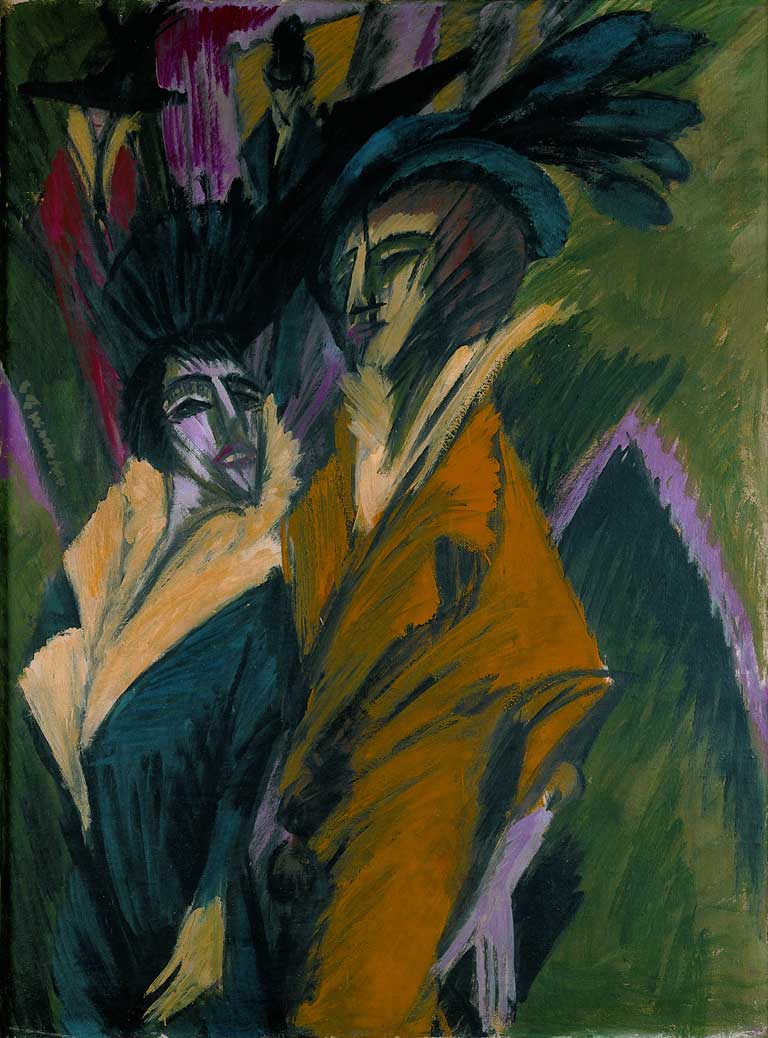Great Works: Two Women in the Street (1914) by Ernst Ludwig Kirchner
Kunstsammlung Nordrhein Westfalen, Düsseldorf

You wince at all these odd shaftings of colours, so savagely thrown down. It feels like the hectic music of that strange man, Anton Webern. Women, you say? Well, what else are these night creatures?
The two oddly menacing forms, with their blockish triangular faces, seem to be cutting with a kind of blade-like savagery through their murky and partially unreadable urban environment. They are daubed in an odd smeary glare of yellow and pink light, garish and slightly repulsive, as if the light itself is so much crudely applied maquillage.
That environment through which they move seems to be closing in upon them even as they push it away with their mannered street strut. Whores or high-society dames pushing out the boat? Everything about them seems sharp – there are so many Vs in this painting, some upright, others inverted – from the cut of their clothes to their sharply attenuated hands, which hang down from them as if limply suspended from a hook.
Kirchner was relatively new to Berlin when he painted such dames. Dresden, where he had once lived, must have seemed so quiet, so morally tidy, by comparison. It was evidently an alarming thrill to be in such a place as this, defined by such creatures as these. They represent a kind of thrilling threat, an alarming bolt of independence. You push them away even as you look. You also want to get a little closer. Are these women animals of a kind or what? Are they in part raptors, which might have emerged from the fevered brain of the doomed painter in Ingmar Bergman's Hour of the Wolf?
The clusters of flurries of brushstrokes out of which the painting is composed help to give them an air of vegetation. They are wrapped in their own dun and green leaves. Their heads are also pugnacious flower heads of a kind. They move through their own realm with a cool measure of indifference. We do not know exactly what is happening around them. It is a jungle of sorts, though an urban jungle. We can almost hear the shrieks of the nocturnal parrots. There is an anonymous bowler- (or top-)hatted predator at their back, soon to be looming up and appraising them. Are they there to be appraised?
There is no point of tranquillity in this painting, nothing dependably quiet or serene, no sequestered spot, nowhere that the eye feels pleased to come to rest. Everything seems to be in a kind of jagged movement, turning, pivoting about itself. There is a luridness about its semi-dark. We feel as if we have just played a flashlight upon these women's faces, bringing them into being hallucinogenically. The colours are harsh and acidic, unnaturally shrill, quite the opposite of soft or winning. We never sink into them appreciatively. They keep us on our toes. They keep us on the edge. We have to have our wits about us in this place. We feel preyed upon by the scene. We didn't especially want it to be like this.
Interestingly, back in England this was the year of the Vorticist moment, spearheaded by Wyndham Lewis and others, when art was all about hardness and geometry, sharp, severe, cutting angles, the reduction of the human form to the mechanised, the human turned chillingly inhuman. That spirit rhymes, perfectly, with what we see here. So much is sharp-angled about these women.
The long, flat bridge of the nose of the woman on the left, for example, looks uncannily similar to the nose of Henri Gaudier-Brzeska's so-called "Hieratic Head", that portrait in marble of the poet Ezra Pound, which was also made in this year. This is an ominous painting, full of foreboding, full of the tease of immoralism. No centre is holding. All we are allowed to settle for, or to acquiesce in (with the maximum of unease), is this terrible, jagged, frieze of a scene across which these mask-like forms, these beings flourishing their dark plumes, appear to drift, utterly contemptuousness of all glances, forever looking away.
About the artist: Ernst Ludwig Kirchner (1880-1938)
Ernst Ludwig Kirchner was an exponent of German Expressionism. In fact, his works, with their harsh colours, their atmosphere of frenzy and the fracturing of the object, seem to embody the very spirit of the movement. His street scenes of Berlin, painted between 1912 and 1914, are his most characteristic Expressionist works. In 1938, having witnessed the political transformation of Germany and seen his art condemned by the Nazi authorities, he committed suicide.
Subscribe to Independent Premium to bookmark this article
Want to bookmark your favourite articles and stories to read or reference later? Start your Independent Premium subscription today.

Join our commenting forum
Join thought-provoking conversations, follow other Independent readers and see their replies